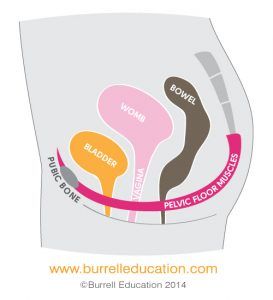Regardless of whether or not you have had a baby, the topic of pelvic floor health is still a taboo.

Most women (and men) feel embarrassed to talk about it. The pelvic floor is just like any other set of muscles and really shouldn’t be seen as something not to be talked about. However, similarly having one that’s a little ‘leaky’ shouldn’t be palmed off as normal. It’s not. Wearing Tenna Ladies at any stage of life isn’t normal and there are things that can be done, to either improve or manage.
Having a baby can obviously affect the function of these amazing little muscles, but so too can menopause, certain illnesses and disorders, poor exercise technique and lifestyle habits. What’s shocking is that the NHS estimate around 3-6 million people in the UK suffer with some degree of incontinence,
Your pelvic floor is just like any other set of muscles and needs to be able to contract (shorten) and relax (lengthen) in order to do its job properly. By just concentrating on ‘squeezing’ we can actually do more harm than good. We need to learn how to let them ‘go’. You certainly wouldn’t walk around with your arm bent all day and expect not to have problems! But what is a non-optimal pelvic floor? It has been said that one that may need a little extra help is one that leaks or has a feeling of pressure- at all (especially during laughing, coughing, sneezing, lifting, or putting strain on them), one that means you need to suddenly ‘go’.
Things such as going ‘just in case’, hovering over the seat, doing pelvic floor exercises on the toilet (stopping/starting), and straining can all contribute. What’s more, for postnatal mums 66% with a diastasis (tummy gap) also have a degree of pelvic floor problems. Why? A lot of muscles that can inhibit the healing of the abdominals are link with the pelvic floor- (see the previous blog about jellyfish!).
Where do you start then? First and foremost I would highly recommend getting in touch with a women’s health physiotherapist. They can be either be found on the NHS or privately. During the session they will ask you about any children and their births, toilet habits, eating and drink habits as well as assessing the pelvic floor and surrounding muscles. From there they can best advise on what you need to be doing going forwards. This could be strengthening the muscles, learning to let them relax or working on urge problems. Going forwards a health and fitness coach may well be able to assist in getting you back to full function in regards to lifestyle and exercise habits. The Holistic Core Restore Coaches® are one set of professionals who can help.
Starting with the usual Kegals can help to form a base to pelvic floor strength but that then needs to be built on. Learning how to breathe, link with the deep abdominal muscles and then apply this to everyday tasks such as getting the washing out the machine or lifting children/heavy things can really make a difference. From there it can be applied to more formal types of exercise.
Other pointers to think about include your posture. If you’re prone to a slumped posture, this can put a lot pressure on the pelvic organs, creating problems. Sit up tall and in neutral, shoulders down and head lengthened, sitting on your sit bones. Ideally you would pee for around the count of 8 Mississippies- this indicate a full but overly-full bladder, nor one that is only partially full. 6-7 voids per day is around average with around 2-3 hours apart and no night-time voids.
This quote from Alfred Hitchcock sums it up nicely: ‘The length of a film should be directly related to the endurance of the human bladder’. This was based on a film lasting around 2 hours.
For more information about women’s health physios in the Bristol area or for exercise and movement please contact Sian at sian@feelgoodfitness.org.

